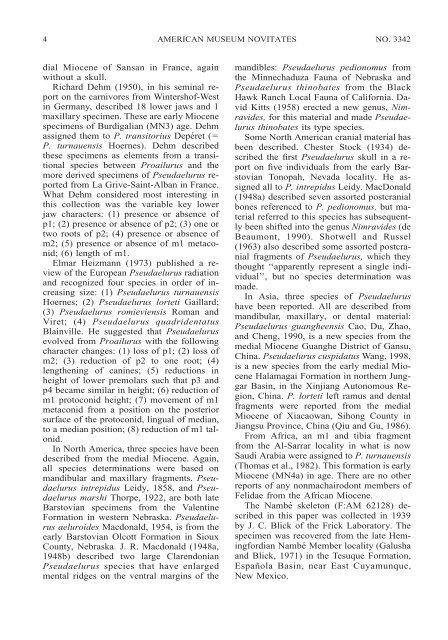A Partial Skeleton of Pseudaelurus (Carnivora: Felidae) - American ...
A Partial Skeleton of Pseudaelurus (Carnivora: Felidae) - American ...
A Partial Skeleton of Pseudaelurus (Carnivora: Felidae) - American ...
Create successful ePaper yourself
Turn your PDF publications into a flip-book with our unique Google optimized e-Paper software.
4 AMERICAN MUSEUM NOVITATES<br />
NO. 3342<br />
dial Miocene <strong>of</strong> Sansan in France, again<br />
without a skull.<br />
Richard Dehm (1950), in his seminal report<br />
on the carnivores from Wintersh<strong>of</strong>-West<br />
in Germany, described 18 lower jaws and 1<br />
maxillary specimen. These are early Miocene<br />
specimens <strong>of</strong> Burdigalian (MN3) age. Dehm<br />
assigned them to P. transitorius Depéret (�<br />
P. turnauensis Hoernes). Dehm described<br />
these specimens as elements from a transitional<br />
species between Proailurus and the<br />
more derived specimens <strong>of</strong> <strong>Pseudaelurus</strong> reported<br />
from La Grive-Saint-Alban in France.<br />
What Dehm considered most interesting in<br />
this collection was the variable key lower<br />
jaw characters: (1) presence or absence <strong>of</strong><br />
p1; (2) presence or absence <strong>of</strong> p2; (3) one or<br />
two roots <strong>of</strong> p2; (4) presence or absence <strong>of</strong><br />
m2; (5) presence or absence <strong>of</strong> m1 metaconid;<br />
(6) length <strong>of</strong> m1.<br />
Elmar Heizmann (1973) published a review<br />
<strong>of</strong> the European <strong>Pseudaelurus</strong> radiation<br />
and recognized four species in order <strong>of</strong> increasing<br />
size: (1) <strong>Pseudaelurus</strong> turnauensis<br />
Hoernes; (2) <strong>Pseudaelurus</strong> lorteti Gaillard;<br />
(3) <strong>Pseudaelurus</strong> romieviensis Roman and<br />
Viret; (4) <strong>Pseudaelurus</strong> quadridentatus<br />
Blainville. He suggested that <strong>Pseudaelurus</strong><br />
evolved from Proailurus with the following<br />
character changes: (1) loss <strong>of</strong> p1; (2) loss <strong>of</strong><br />
m2; (3) reduction <strong>of</strong> p2 to one root; (4)<br />
lengthening <strong>of</strong> canines; (5) reductions in<br />
height <strong>of</strong> lower premolars such that p3 and<br />
p4 became similar in height; (6) reduction <strong>of</strong><br />
m1 protoconid height; (7) movement <strong>of</strong> m1<br />
metaconid from a position on the posterior<br />
surface <strong>of</strong> the protoconid, lingual <strong>of</strong> median,<br />
to a median position; (8) reduction <strong>of</strong> m1 talonid.<br />
In North America, three species have been<br />
described from the medial Miocene. Again,<br />
all species determinations were based on<br />
mandibular and maxillary fragments. <strong>Pseudaelurus</strong><br />
intrepidus Leidy, 1858, and <strong>Pseudaelurus</strong><br />
marshi Thorpe, 1922, are both late<br />
Barstovian specimens from the Valentine<br />
Formation in western Nebraska. <strong>Pseudaelurus</strong><br />
aeluroides Macdonald, 1954, is from the<br />
early Barstovian Olcott Formation in Sioux<br />
County, Nebraska. J. R. Macdonald (1948a,<br />
1948b) described two large Clarendonian<br />
<strong>Pseudaelurus</strong> species that have enlarged<br />
mental ridges on the ventral margins <strong>of</strong> the<br />
mandibles: <strong>Pseudaelurus</strong> pedionomus from<br />
the Minnechaduza Fauna <strong>of</strong> Nebraska and<br />
<strong>Pseudaelurus</strong> thinobates from the Black<br />
Hawk Ranch Local Fauna <strong>of</strong> California. David<br />
Kitts (1958) erected a new genus, Nimravides,<br />
for this material and made <strong>Pseudaelurus</strong><br />
thinobates its type species.<br />
Some North <strong>American</strong> cranial material has<br />
been described. Chester Stock (1934) described<br />
the first <strong>Pseudaelurus</strong> skull in a report<br />
on five individuals from the early Barstovian<br />
Tonopah, Nevada locality. He assigned<br />
all to P. intrepidus Leidy. MacDonald<br />
(1948a) described seven assorted postcranial<br />
bones referenced to P. pedionomus, but material<br />
referred to this species has subsequently<br />
been shifted into the genus Nimravides (de<br />
Beaumont, 1990). Shotwell and Russel<br />
(1963) also described some assorted postcranial<br />
fragments <strong>of</strong> <strong>Pseudaelurus</strong>, which they<br />
thought ‘‘apparently represent a single individual’’,<br />
but no species determination was<br />
made.<br />
In Asia, three species <strong>of</strong> <strong>Pseudaelurus</strong><br />
have been reported. All are described from<br />
mandibular, maxillary, or dental material:<br />
<strong>Pseudaelurus</strong> guangheensis Cao, Du, Zhao,<br />
and Cheng, 1990, is a new species from the<br />
medial Miocene Guanghe District <strong>of</strong> Gansu,<br />
China. <strong>Pseudaelurus</strong> cuspidatus Wang, 1998,<br />
is a new species from the early medial Miocene<br />
Halamagai Formation in northern Junggar<br />
Basin, in the Xinjiang Autonomous Region,<br />
China. P. lorteti left ramus and dental<br />
fragments were reported from the medial<br />
Miocene <strong>of</strong> Xiacaowan, Sihong County in<br />
Jiangsu Province, China (Qiu and Gu, 1986).<br />
From Africa, an m1 and tibia fragment<br />
from the Al-Sarrar locality in what is now<br />
Saudi Arabia were assigned to P. turnauensis<br />
(Thomas et al., 1982). This formation is early<br />
Miocene (MN4a) in age. There are no other<br />
reports <strong>of</strong> any nonmachairodont members <strong>of</strong><br />
<strong>Felidae</strong> from the African Miocene.<br />
The Nambé skeleton (F:AM 62128) described<br />
in this paper was collected in 1939<br />
by J. C. Blick <strong>of</strong> the Frick Laboratory. The<br />
specimen was recovered from the late Hemingfordian<br />
Nambé Member locality (Galusha<br />
and Blick, 1971) in the Tesuque Formation,<br />
Española Basin, near East Cuyamunque,<br />
New Mexico.

















